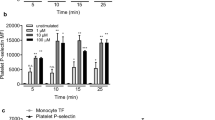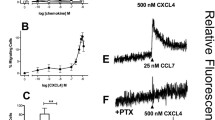Abstract
Thrombin, in addition to being a key enzyme in haemostasis, affects a series of endothelial and leukocyte functions, and thus may be involved in the regulation of inflammatory reaction. Since leukocyte recruitment and activation are important events in inflammatory and thrombotic processes, in this study we have examined the possibility that thrombin can induce the production of a cytokine chemotactic for mononuclear phagocytes. Human peripheral blood mononuclear cells (PBMC) exposed in vitro to thrombin expressed transcript of monocyte chemotactic protein-1 (MCP-1, alternative acronyms: JE, monocyte chemotactic and activating protein, tumor derived chemotactic factor). Among circulating mononuclear cells, monocytes were identified as the cells expressing MCP-1 in response to thrombin. Thrombin was two to three fold less effective than endotoxin in inducing MCP-1 transcript in PBMC. In addition to monocyte, also endothelial cells (EC) expressed MCP-1 in response to thrombin, although at lower levels compared to monocyte. Actinomycin D experiments indicated that induction of MCP-1 by thrombin in PBMC and in EC was gene transcription dependent. The protein synthesis inhibitor cycloheximide blocked thrombin-induced MCP-1 expression in PBMC, whereas it superinduced both constitutive and thrombin-induced expression of MCP-1 in EC, indicating different mechanism of regulation of this gene in mononuclear phagocytes versus other cell types. Thrombin stimulated mononuclear cells and endothelial cells to release chemotactic activity for monocytes that could be at least partially inhibited by absorption with anti-MCP antibodies. It is well known that thrombin is involved in inflammation: it induces a series of functional modifications in endothelial cells (secretion of PGI2 and IL-1), it is chemotactic for monocytes and it degrades some components of basal membrane; moreover endothelial cells are strategically located at the interface between blood and tissue and upon exposure to inflammatory signals (LPS, IL-1) monocytes and endothelial cells express cell associated procoagulant activity: hence, the induction of MCP-1 by thrombin may be an important mechanism in the recruitment of monocytes at sites of vasculary injury. These data further indicate that blood coagulation, inflammatory reaction and immunity interact closely.
Access this chapter
Tax calculation will be finalised at checkout
Purchases are for personal use only
Similar content being viewed by others
Author information
Authors and Affiliations
Editor information
Editors and Affiliations
Rights and permissions
Copyright information
© 1993 Springer Science+Business Media New York
About this chapter
Cite this chapter
Sciacca, F.L., Colotta, F., Sironi, M., Luini, W., Mantovani, A. (1993). Expression of Monocyte Chemotactic Protein-1 (Mcp-1) by Monocytes and Endothelial Cells Exposed to Thrombin. In: Lindley, I.J.D., Westwick, J., Kunkel, S. (eds) The Chemokines. Advances in Experimental Medicine and Biology, vol 351. Springer, Boston, MA. https://doi.org/10.1007/978-1-4615-2952-1_30
Download citation
DOI: https://doi.org/10.1007/978-1-4615-2952-1_30
Publisher Name: Springer, Boston, MA
Print ISBN: 978-1-4613-6283-8
Online ISBN: 978-1-4615-2952-1
eBook Packages: Springer Book Archive




